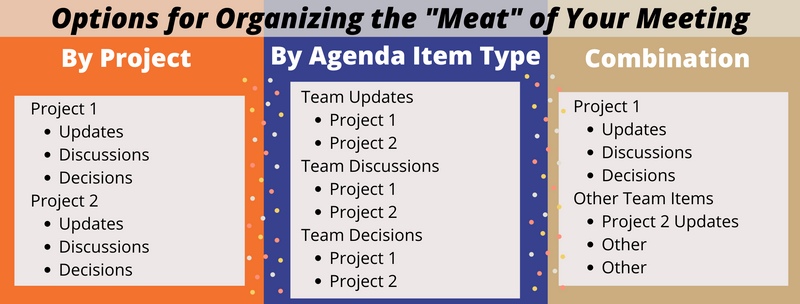
This logo isn't an ad or affiliate link. It's an organization that shares in our mission, and empowered the authors to share their insights in Byte form.
Rumie vets Bytes for compliance with our
Standards.
The organization is responsible for the completeness and reliability of the content.
Learn more
about how Rumie works with partners.
Let's say you have a great group of people and a clear goals you want to accomplish together.
How can you bring these different perspectives together to work towards your collective goals?
Managing productive meetings is an important place to start.
Determine The Background Logistics: What, Who, When, & Where
WHAT SHOULD BE ACCOMPLISHED? (YOUR AGENDA ITEMS)
During the meeting, you may want to accomplish some or all of the following:
Hear update(s) from key stakeholders (Example: A team member has collected data that other team members need to know.)
Discuss decision(s) that need to be made (Example: The team needs to hear multiple perspectives on the benefits and challenges of multiple solutions.)
Reach a consensus about how to move forward with a decision (Example: After hearing multiple perspectives, the team members vote on the best path forward.)
WHO WILL BE ATTENDING?
Consider how each team member's perspective can contribute to the overall team goal.
Is it important for each person to have an opportunity to share updates or their perspectives? If so, you can designate a section for "reports" from each person.
WHEN WILL THIS MEETING TAKE PLACE?
When will the meeting take place, and how long will it last?
Overestimate how long each agenda item will take, especially discussions. It is much better to leave a meeting early than to ask your team members to stay longer than you originally predicted!
Consider how the timing of the meeting fits into other events taking place for your team. (Example: A team meeting the night before an important event would be a great time to review last-minute logistics, identify who will be attending the event, and get the team members excited!)
WHERE WILL THIS MEETING TAKE PLACE?
Think about space, furniture, and technology considerations.
 If you have a small group of people and want to have lots of discussions, it is best to arrange the meeting in a circular format.
If you have a small group of people and want to have lots of discussions, it is best to arrange the meeting in a circular format.
 If you have a large group of people, you will need a larger space. Think about how you will help team members' voices be heard (such as with a microphone). Place people who you already know will need to speak towards the front of the room (such as the vice president of an organization).
If you have a large group of people, you will need a larger space. Think about how you will help team members' voices be heard (such as with a microphone). Place people who you already know will need to speak towards the front of the room (such as the vice president of an organization).
Quiz
What factors are important to consider when planning a meeting?
From logistics such as the design and capacity of the meeting room, to information that impacts the team's goals, all of these factors must be considered when planning a meeting.
Determine The How: In What Order Do You Arrange Your Agenda Items?
MEETING INTRODUCTION
The introduction of a meeting can be an opportunity for:
Introductions for team members who do not already know one another
Team-building activities (such as a short game or fun activity)
Team development (such as a quick lesson about a skill that will help team members accomplish their goals)
Morale-boosting (such as checking in on team members' health or recognizing team members' achievements)
THE "MEAT" OF THE MEETING
Arrange your agenda items in a way that makes sense. Consider various updates, discussions, or decisions that may impact one another.
You can sort the agenda items by project, type of item, or a combination of these.

CONCLUSION: Where do we go from here?
After you have accomplished all agenda items, ensure your team members leave with a sense of accomplishment and purpose.
Assign roles/jobs to certain stakeholders that need to be accomplished before the next meeting.
Identify logistics (date, time, location) for next meeting.
Identify action items and goals for the next meeting.
Quiz
Scenario: You are planning a meeting for your team. Recently, the team has been falling behind in meeting deadlines for your most important upcoming project. Which of these items would be the LEAST important for meeting your goals?
Though discussing ideas for a new project may be exciting, the team's priority is accomplishing the project they are falling behind in. Therefore, you should build the agenda around ensuring the team can accomplish that project first.
Did you know?
Take Action
Use what you've learned to adjust the plan for your next meeting, and remember:
There is no one-size-fits-all approach to planning meetings. Experiment and figure out what works best for your team! This could involve asking team members for input on how they believe meetings should be structured.
Be sure to share the agenda with your team members ahead of time. This helps team members prepare for discussions and decision-making, bring anything they need to be successful, and request additions to the agenda if needed.
This Byte has been authored by
Alaina Peters
Comfortably straddling the hyphen of "scholar-practitioner" in the higher education/student affairs field: proven excellence in qualitative research, benchmarking, and assessment work while centering individual collaborative relationships that empower, challenge, and strengthen student leaders. Primary interests: cocurricular leadership development programs, student organization support, community engagement/service learning, and the intersections between academic and student affairs.
